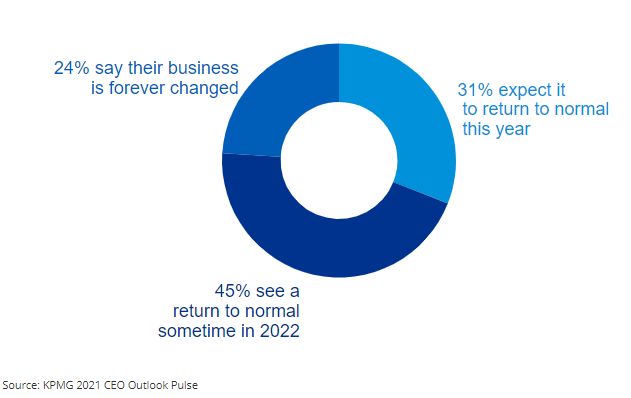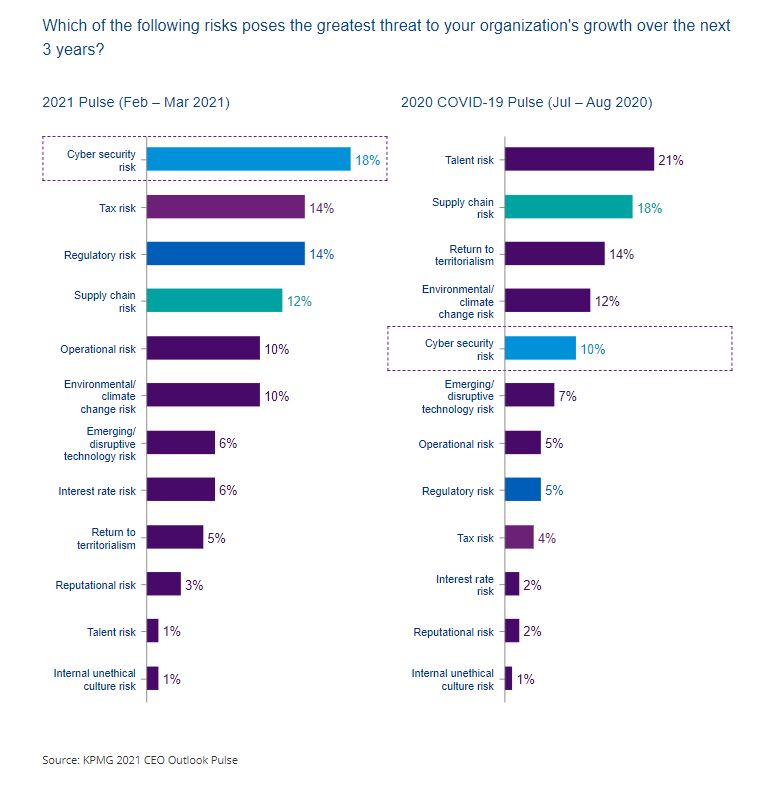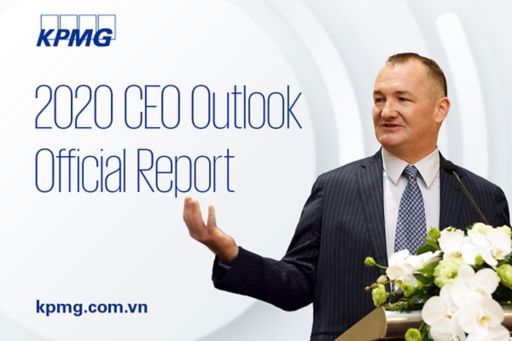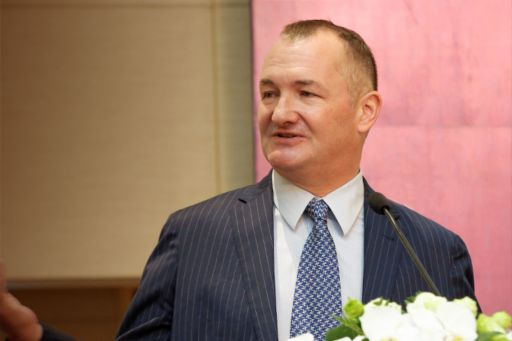No return to normal in the near-term
According to the 2021 CEO Outlook Pulse Survey, CEOs of the world’s most influential companies are planning what a return to ‘normal’ will look like, mindful that their workforces’ potential lack of access to a COVID-19 vaccine could force them to rethink their strategies.
Our 2020 CEO Outlook COVID-19 Pulse Survey revealed that executives were focused on stabilizing their business amid immediate unknowns, while our 2021 Pulse Survey, conducted in February and March, indicates that CEOs have a clearer, near-to mid-term strategy. In particular, close to half (45 percent) articulated that a return to ‘normal’ will not occur this year.
Based on a survey of 500 CEOs in 11 key markets, our 2021 Pulse Survey provides a timely snapshot of CEOs’ views on business growth resumption, their views on vaccine distribution, their top-of-mind organizational risks, and business transformation priorities going forward.
“Before any major decisions are made, CEOs want to be confident that their workforce is protected against this virus. The COVID-19 vaccine rollout is providing leaders with a dose of optimism as they prepare for a new reality. CEOs are scenario planning for certain key markets that may experience vaccine shortages that could impact their operations, supply chains and people, leading to uneven economic recovery.”
Return to ‘normal’ in 2022
CEOs of the world’s most influential companies are planning what a return to ‘normal’ will look like, but their workforces’ lack of access to a COVID-19 vaccine is forcing them to rethink their strategies. With only one-third (31 percent) anticipating a return to normal in 2021, nearly half (45 percent) expect normality to resume in 2022. Significantly, 24 percent of leaders say that their business has changed forever.

Though many factors can influence CEO predictions, the perceived pace of vaccination distribution is prominent. More than half (55 percent) of business leaders state they are concerned that not all of their employees will have access to a COVID-19 vaccine, which could put their operations or certain markets at a competitive disadvantage.
As a result, nearly two-thirds (61 percent) of companies will await a successful vaccine rollout in key markets[1] before they ask staff to return to the office. Prudently, three-quarters (76 percent) of companies will wait for governments in key markets to encourage businesses to return to normal, whereas just 5 percent will do so based on the actions by their competitors or similar businesses. A significant majority (90 percent) of CEOs intend to ask employees to report when they have been vaccinated, which will help organizations consider measures to protect their workforce. However, one-third (34 percent) of global executives are worried about misinformation on COVID-19 vaccine safety and the potential this may have on employees choosing not to have it administered.
Defining rules in the ‘new reality’
Safety of their staff dominate CEOs’ plans to operate in the new business landscape. For example, 21 percent of companies will ask clients and visitors to their facilities if they have been vaccinated. They are also taking a cautious approach to business travel, with 26 percent planning to cut down on international travel until the pandemic concludes.
Although they point to several long-term impacts upon the way they will operate going forward, business leaders showed a measured approach to key issues like office space reductions and remote work arrangements. For instance, just 17 percent say they will downsize their company’s physical footprint, whereas 69 percent of those surveyed in August 2020 said they would do so. And, just 30 percent will have a majority of employees working remotely between 2-3 days per week.
Companies are definitely transforming key aspects of their workplace and service delivery, with 61 percent stating they will build upon their digital collaboration and communication tools. More than half (57 percent) plan to conduct customer engagement and queries predominantly via virtual platforms such as chat bots, telephone, web and social media.
In light of heightened awareness of workforce stress and societal issues during the pandemic, 50 percent of companies will increase their HR resources to help manage employee wellbeing and mental health, and 14 percent will examine shared office spaces to increase employee workplace flexibility.
Confidence up, despite shifting risks
The survey results paint a mixed picture, as CEOs are slightly more confident about their company, sector and country over the 3-year horizon than they were last year. The additional confidence can be attributed to the positive momentum of the COVID-19 vaccine rollout, but further lockdowns have had a negative impact on the global economic outlook. By contrast, CEO confidence in the global economy is at its lowest since 2017.
Fueling these sentiments, CEOs identified their greatest risk to company growth over the next 3 years. Among the key trends, cyber security risk emerged as the number one risk, rising dramatically from fifth place in August 2020. Also rising significantly among CEO priorities: regulatory risk and tax risk tied for second place, while supply chain risk ascended to third place from eighth spot in February 2020.

With COP26 taking place this year and the US re-joining the Paris Accord, 49 percent of CEOs plan to put in place more stringent ESG practices. A vast majority (89 percent) of business leaders are focused on locking in the sustainability and climate change gains their companies have made as a result of the pandemic. Nearly all (96 percent) global executives are looking to upweight their focus towards the social component of their ESG programs.
Doubling down on digital:
Though the pandemic prompted many organizations to rethink their existing strategies, it only served to intensify business leaders’ commitment to digitization. In fact, as companies move from crisis mode and attempt to normalize operations, CEOs are shifting their focus to cyber security issues and differentiating themselves through their digital connectivity with customers.
Three-quarters (74 percent) of business leaders report that the digitization of their operations and creation of a next-generation operating model, have accelerated by a matter of months, up from 50 percent in August 2020. A sizeable majority of leaders have reported acceleration of new digital business models and revenue streams (69 percent) and to develop a seamless digital customer experience (56 percent).
This year, CEOs plan to spend more on digital technologies than last year, with 52 percent prioritizing data security measures, 50 percent focusing on customer-centric technologies, and 49 percent committed to digital communications, such as video conferencing and messaging capabilities.
They will also pursue various avenues to bulk up their digital capabilities, since 61 percent state that their M&A appetite over the next 3 years will be driven mainly by the desire to acquire digital technology to transform their customer experience or value proposition.
Conclusions
Now that a year has passed since the pandemic first stirred abrupt uncertainty and change, CEOs have found their footing in stabilizing their operations. Though few business leaders anticipate a speedy return to normal, they have a strong understanding of the requirements to ‘restore normalcy’ in the way they work. They also have a clear vision of actions required to reassert their competitiveness in a forever-changed marketplace, including building on their accelerated digital and ESG activities over the past year.
To continue the dialogue about these trends, and their significance, we’ll continue to share more key findings from the survey, and insightful perspectives from our KPMG leadership team in this space.
Methodology:
The Pulse Survey asks CEOs from the world’s most influential companies to provide their 3-year outlook on the economic and business landscape, as well as the ongoing COVID-19 pandemic. This Pulse Survey looks at how their views have evolved since July/August 2020.
Five hundred CEOs from 11 key markets (Australia, Canada, China, France, Germany, India, Italy, Japan, Spain, the UK and the US) were surveyed from 29 January - 4 March 2021. It covers 11 key industry sectors (asset management, automotive, banking, consumer and retail, energy, infrastructure, insurance, life sciences, manufacturing, technology and telecommunications). All respondents represent organizations that have annual revenue over US$500M and 35 percent of the companies surveyed have more than US$10B in annual revenue.






